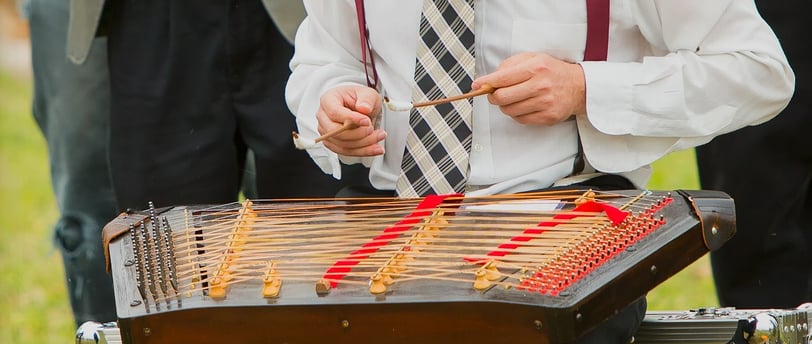How I learned Tsibml
David Ansel describes his journey from a casual musician to a dedicated performer in klezmer music, highlighting his self-taught mastery of the cimbalom and involvement in a musical Shabbat service.
David Ansel
12/2/20243 min read


I spent most of my adult life as a closet and/or porch musician. A little strumming on guitar, a little tinkling on piano. I would play guitar by ear and piano by reading, and I could do neither vice versa. Eventually, after my daughter was born, I decided to take a few music lessons, both guitar and piano. It helped me heal that divide between playing by music and by ear. Once I picked up accordion (I started by renting one for a month), learning the left hand buttons really helped me conceptualize music theory, since the rows of buttons are arranged by the cycle of fifths.
During this period, I began a musical Shabbat service with Rabbi Rachel Kobrin, formerly of Congregation Agudas Achim. It was our vision to make it musical, but we didn’t know how to bring that to fruition. I stepped up, learned how to put together a small ensemble, chart the music, set up a PA, and perform for the services. That is when I tell people I “came out of the closet” as a musician (my home office is inside our somewhat oversized bedroom walk-in closet).
I ran into Samantha at this point and invited her to bring Mazel Tov Kocktail Hour to perform at our Shabbat service. Thus began our long-standing musical relationship. Samantha is like a baseball general manager… she tries to keep her farm system stocked with up-and-coming musicians. I began in the minors, so to speak, and would practice klezmer tunes with her. She and Mark Rubin got a group of people together to learn klezmer, to listen to some tunes, what we call “source recordings.” In those tunes I heard a strangely delightful instrument and found out that it was called a cimbalom, or “tsimbl” in Yiddish. Knowing that with Dylan around, I would never find my way into the majors as an accordionist, I thought perhaps this was a potential path for me.
I looked on eBay and there was exactly one cimbalom available for sale, built by a wonderful Romanian player named Nic Feraru. It was very small but seemed affordable and good enough to start with. It arrived in a cardboard box with two sticks and a paper showing the tuning of the strings. That’s it and that’s all. There were and I believe to this day are no videos or books showing how to play the thing, so I just started plunking away at it and figuring out where the notes were, where the arpeggios are, etc. Although it is a harp, it’s not really laid out in any linear fashion like a regular harp or piano. I tell people it’s like learning to type. The letters are not exactly sensibly arranged, you just have to develop the muscle memory.
Sam & Dylan and others in the band at the time were extremely accommodating and welcoming to me… my first efforts were extremely halting and limited, but over the years I have gained some fluidity to my playing and invested in three more cimbaloms of increasing size and quality. It is really a labor of love… extremely difficult to transport and tune. Still I have had extremely limited support in learning the instrument. Pete Rushevsky of Brooklyn has welcomed me into his home a few times to learn some tunes and techniques. When I went to the final KlezKamp in the Catskills, I unfortunately found zero support from the few people who had experience to share.
The tsimbl is an original old-country klezmer instrument that didn’t quite make the trip to America. As klezmer became louder and the bands became bigger, the tsimbl was simply made somewhat obsolete. I think it lends our band a lovely percussive sparkle and occasionally ominous sonic carpet. It has a strange clangor and even stranger wobbly sustain. I love it and am truly honored to be able to participate in the continuation of this amazing art form.
